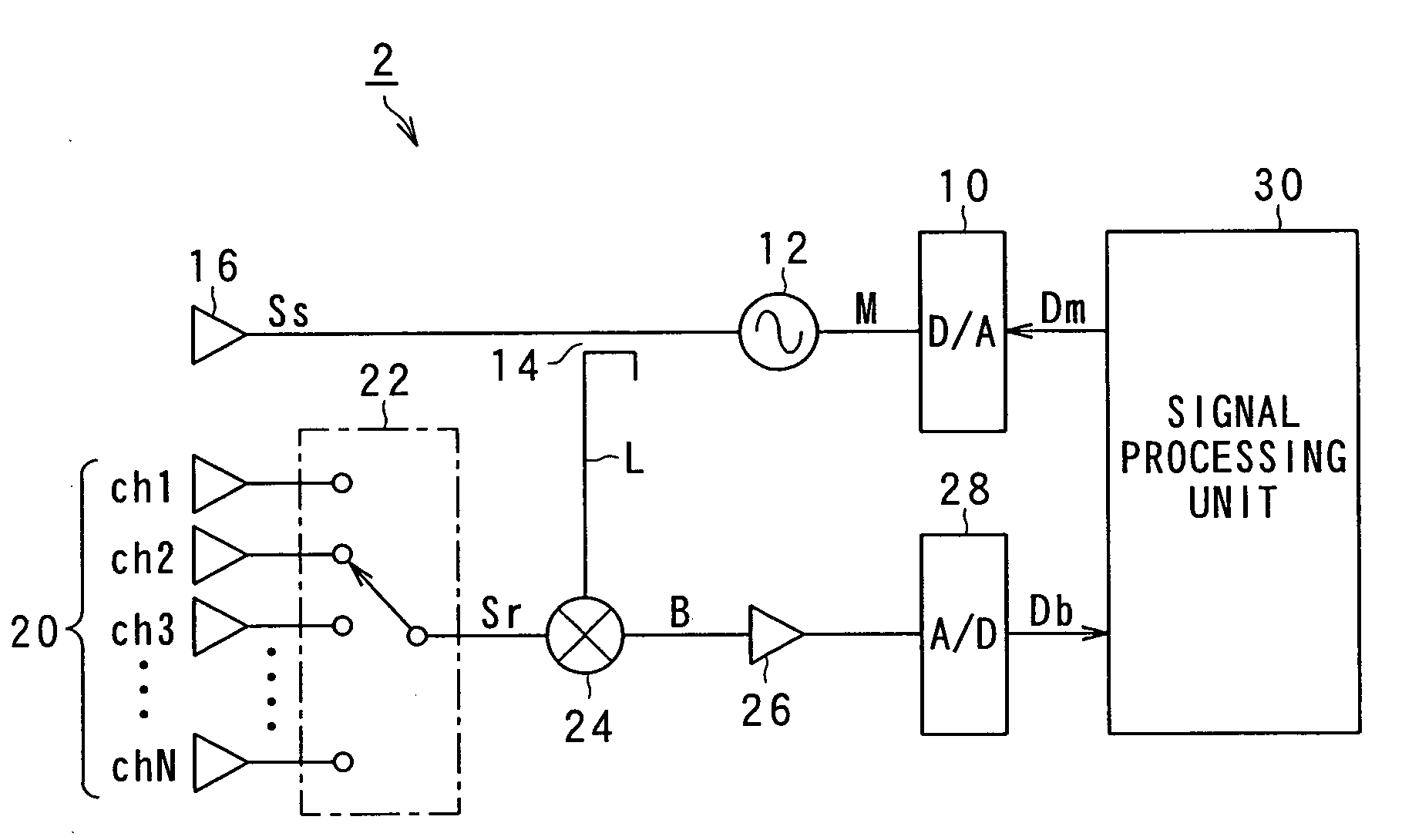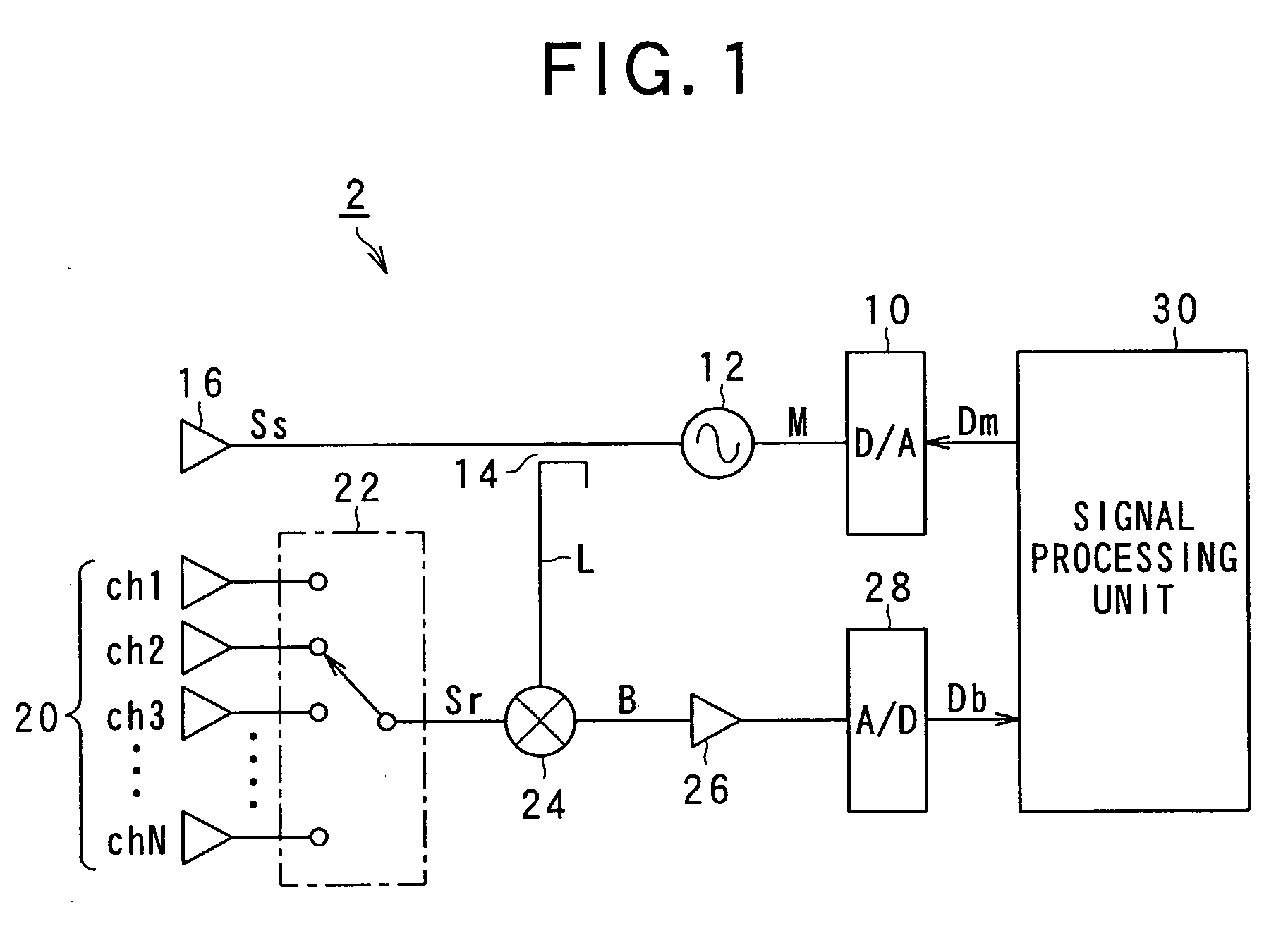Method for detecting interference in radar system and radar using the same
a radar system and radar technology, applied in the field of radar system and radar interference detection, can solve the problems of unreliable range measurement obtained from a two-frequency cw radar in the presence of multiple target objects, interference between the fmcw radar with which the subject vehicle is equipped and the other radar installed in the other vehicle, and poor performance of two-frequency cw radar
- Summary
- Abstract
- Description
- Claims
- Application Information
AI Technical Summary
Benefits of technology
Problems solved by technology
Method used
Image
Examples
first embodiment
[0085]Referring to FIGS. 1-16, a first embodiment and its modifications of the present invention will be discussed.
[0086]FIG. 1 is a block diagram showing a vehicle-mounted FMCW radar according to the present invention. The FMCW radar detects the distance to a target object located in a radar range (hereinafter it sometimes will be referred as to a “measuring distance range”) and / or a relative speed of the target object such as a preceding vehicle.
[0087]As shown in FIG. 1, the FMCW radar 2 includes a digital-analog (D / A) converter 10, an oscillator 12, a splitter 14, a transmitting antenna 16, and a signal processing unit 30.
[0088]The D / A converter 10 receives digital data Dm from the signal processing unit 30 and converts the received digital data Dm to an analog signal M. The oscillator 12 receives the analog signal M from the D / A converter 10 and thereby generates a radio frequency signal in the millimeter wave band, the frequency of the signal varying in time according to inform...
second embodiment
[0206]Referring to FIG. 17, a second embodiment of the present invention will be discussed.
[0207]FIG. 17 is a flow chart showing process for calculating the reference value according to the second embodiment of the present invention, the process including steps of identifying a peak frequency interval containing one of peak frequency components having a peak intensity larger than the predetermined threshold value in frequency spectrum characteristic of the beat signal, and replacing the peak Intensity with zero level in the intensity.
[0208]In this embodiment, operation at step S130 in FIG. 5 for calculating the first and the second reference values with respect to each of the frequency increasing section and the frequency decreasing section is modified from that in the first embodiment. So, in the following, operation for calculating the first and the second reference values according to the present embodiment will be explained.
[0209]In the present embodiment, the following operatio...
third embodiment
[0231]Referring to FIG. 18-19B, a third embodiment of the present invention will be discussed.
[0232]In this embodiment, operation at step S130 in FIG. 5 for calculating the first and the second reference values with respect to each of the frequency increasing section and the frequency decreasing section is modified from that in the first embodiment. So, in the following, operation for calculating the first and the second reference values according to the present embodiment will be explained.
[0233]FIG. 18 is a flow chart showing a process for calculating the integral value according to a third embodiment of the present invention, the process including steps of identifying a peak frequency interval containing one of the frequency components having intensity larger than the predetermined threshold value in frequency spectrum characteristic of the beat signal, and replacing the peak intensity with zero level in the intensity.
[0234]In the present embodiment, the following operation will ...
PUM
 Login to View More
Login to View More Abstract
Description
Claims
Application Information
 Login to View More
Login to View More - R&D
- Intellectual Property
- Life Sciences
- Materials
- Tech Scout
- Unparalleled Data Quality
- Higher Quality Content
- 60% Fewer Hallucinations
Browse by: Latest US Patents, China's latest patents, Technical Efficacy Thesaurus, Application Domain, Technology Topic, Popular Technical Reports.
© 2025 PatSnap. All rights reserved.Legal|Privacy policy|Modern Slavery Act Transparency Statement|Sitemap|About US| Contact US: help@patsnap.com



